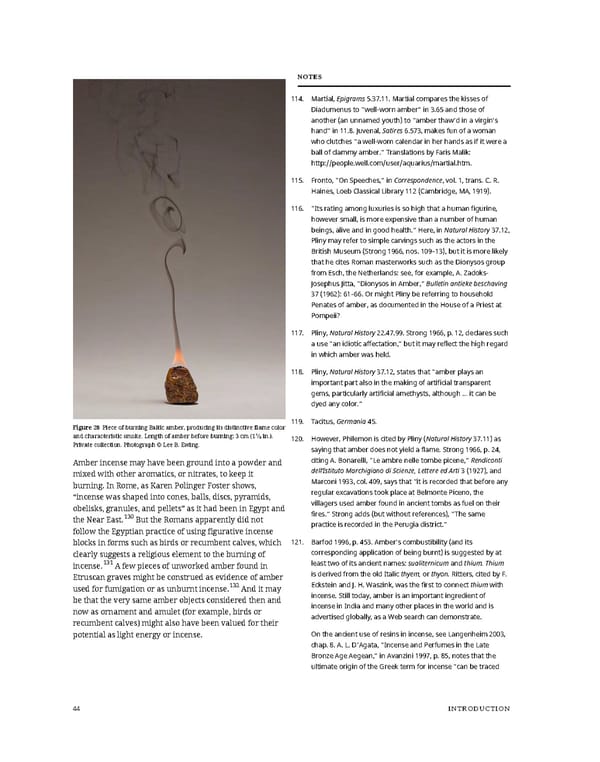NOTES 114. Martial, Epigrams 5.37.11. Martial compares the kisses of Diadumenus to “well-worn amber” in 3.65 and those of another (an unnamed youth) to “amber thaw’d in a virgin’s hand” in 11.8. Juvenal, Satires 6.573, makes fun of a woman who clutches “a well-worn calendar in her hands as if it were a ball of clammy amber.” Translations by Faris Malik: http://people.well.com/user/aquarius/martial.htm. 115. Fronto, “On Speeches,” in Correspondence, vol. 1, trans. C. R. Haines, Loeb Classical Library 112 (Cambridge, MA, 1919). 116. “Its rating among luxuries is so high that a human figurine, however small, is more expensive than a number of human beings, alive and in good health.” Here, in Natural History 37.12, Pliny may refer to simple carvings such as the actors in the British Museum (Strong 1966, nos. 109–13), but it is more likely that he cites Roman masterworks such as the Dionysos group from Esch, the Netherlands: see, for example, A. Zadoks- Josephus Jitta, “Dionysos in Amber,” Bulletin antieke beschaving 37 (1962): 61–66. Or might Pliny be referring to household Penates of amber, as documented in the House of a Priest at Pompeii? 117. Pliny, Natural History 22.47.99. Strong 1966, p. 12, declares such a use “an idiotic affectation,” but it may reflect the high regard in which amber was held. 118. Pliny, Natural History 37.12, states that “amber plays an important part also in the making of artificial transparent gems, particularly artificial amethysts, although … it can be dyed any color.” Piece of burning Baltic amber, producing its distinctive flame color 119. Tacitus, Germania 45. Figure 28 and characteristic smoke. Length of amber before burning: 3 cm (11⁄8 in.). 120. However, Philemon is cited by Pliny (Natural History 37.11) as Private collection. Photograph © Lee B. Ewing. saying that amber does not yield a flame. Strong 1966, p. 24, Amber incense may have been ground into a powder and citing A. Bonarelli, “Le ambre nelle tombe picene,” Rendiconti mixed with other aromatics, or nitrates, to keep it dell’Istituto Marchigiano di Scienze, Lettere ed Arti 3 (1927), and burning. In Rome, as Karen Polinger Foster shows, Marconi 1933, col. 409, says that “it is recorded that before any “incense was shaped into cones, balls, discs, pyramids, regular excavations took place at Belmonte Piceno, the obelisks, granules, and pellets” as it had been in Egypt and villagers used amber found in ancient tombs as fuel on their the Near East.130 But the Romans apparently did not fires.” Strong adds (but without references), “The same follow the Egyptian practice of using figurative incense practice is recorded in the Perugia district.” blocks in forms such as birds or recumbent calves, which 121. Barfod 1996, p. 453. Amber’s combustibility (and its clearly suggests a religious element to the burning of corresponding application of being burnt) is suggested by at incense.131 A few pieces of unworked amber found in least two of its ancient names: sualiternicum and thium. Thium Etruscan graves might be construed as evidence of amber is derived from the old Italic thyem, or thyon. Ritters, cited by F. used for fumigation or as unburnt incense.132 And it may Eckstein and J. H. Waszink, was the first to connect thium with be that the very same amber objects considered then and incense. Still today, amber is an important ingredient of now as ornament and amulet (for example, birds or incense in India and many other places in the world and is recumbent calves) might also have been valued for their advertised globally, as a Web search can demonstrate. potential as light energy or incense. On the ancient use of resins in incense, see Langenheim 2003, chap. 8. A. L. D’Agata, “Incense and Perfumes in the Late Bronze Age Aegean,” in Avanzini 1997, p. 85, notes that the ultimate origin of the Greek term for incense “can be traced 44 INTRODUCTION
 Ancient Carved Ambers in the J. Paul Getty Museum Page 53 Page 55
Ancient Carved Ambers in the J. Paul Getty Museum Page 53 Page 55